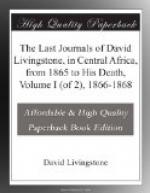The chief gave me a public reception, which was like that of Casembe, but better managed. He is young, and very handsome but for a defect in his eyes, which makes him keep them half shut or squinting. He walked off in the jaunty way all chiefs do in this country, to show the weight of rings and beads on the legs, and many imitate this walk who have none, exactly as our fathers imitated the big cravat of George IV., who thereby hid defects in his neck: thousands carried their cravats over the chin who had no defects to hide. Moenempanda carried his back stiffly, and no wonder, he had about ten yards of a train carried behind it. About 600 people were present. They kept rank, but not step; were well armed; marimbas and square drums formed the bands, and one musician added his voice: “I have been to Syde” (the Sultan); “I have been to Meereput” (King of Portugal); “I have been to the sea.” At a private reception, where he was divested of his train, and had only one umbrella instead of three, I gave him a cloth. The Arabs thought highly of him; but his graciousness had been expended on them in getting into debt; he now showed no inclination to get out of it, but offered about a twentieth part of the value of the goods in liquidation. He sent me two pots of beer, which I care not to drink except when very thirsty on a march, and promised a man to guide me to Chikumbi, and then refused. Casembe rose in the esteem of all as Moenempanda sank, and his people were made to understand how shabbily he had behaved.
The Lulaputa is said to flow into the Luena, and that into the Luongo: there must be two Luenas.
22nd June, 1868.—March across a grassy plain southerly to the Luongo, a deep river embowered in a dense forest of trees, all covered with lichens—some flat, others long and thready, like old men’s beards, and waving in the wind, just as they do on the mangrove-swamp trees on the coast. The Luongo here is fifty yards broad and three fathoms deep; near its junction with the Luapula it is 100 yards; it rises here to eight fathoms’ depth. A bridge of forty yards led us over to an island, and a branch of the river was ten yards beyond: the bridge had been broken, some thought on purpose, but it was soon mended with trees eighteen to twenty yards long. We went a little way beyond, and then halted for a day at a rivulet flowing into the Luongo, 200 yards off.
23rd June, 1868.—We waited for copper here, which was at first refused as payment of debt. I saw now that the Luongo had steep clay banks fifteen feet down, and many meadows, which must be swimming during the rains. The Luena is said to rise east of this.
[In a private letter Livingstone shows that he had seldom been more affected by the sufferings of slaves than at this time, and it would perhaps be difficult to imagine any scene more calculated to excite misery and distress of mind.
The following incident deals with the firm belief in a future state, which enters so largely into the minds of all Africans, and which for very lack of guidance assumes all the distorted growths of superstition.




